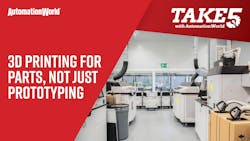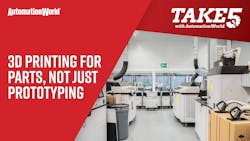3D Printing for Parts, Not Just Prototyping

Quick hits:
- See some of the production parts now produced by 3D printing.
- How Ford and Nissan are using 3D printing as part of their sustainability strategy.
- Learn how 3D printing is being used to produce out-of-production parts to help manufacturers avoid mold storage and inventory issues.
Related to this episode:
- 3D printing core to GE's newest advanced manufacturing facility
- How 3D printing is changing production
- RobotStudio brings 3D printing capabilities to ABB Robots
- Additive manufacturing comes to oil and gas
- Learn about PMMI's OpX leadership network and how it provides solutions for the industry's most pressing challenges
I'm David Greenfield, director of content for Automation World, and thanks for joining me on this Take Five episode, where I'll be highlighting how 3D printing is increasingly becoming a critical technology for manufacturers.
For years now, we've all watched as 3D printing—also often referred to as additive manufacturing for the way it layers materials to create a product—improved incrementally and became an important tool for prototyping. And even with all the advances made in simulation software over the years, 3D printed prototypes still serve a purpose in numerous applications to spotlight how a part may act during different testing scenarios. But it's the application of 3D printing to produce actual production parts that holds the greatest potential for manufacturing beyond product design and development. And that process has been expanding at a rapid rate.
For example, back in 2014, we covered how GE Aviation began using additive manufacturing to produce the interiors of fuel nozzles for the LEAP jet engines manufactured by CFM International. And more recently, in 2019, we covered how HP was using additive manufacturing to create parts for its own 3D printers, as well as how Emerson designed its Cavitrol Hex anti-cavitation trim for the Fisher Vee-Ball rotary control valve to be produced using additive manufacturing as well.
Another industrial automation technology supplier, ABB, has integrated the 3D printing capabilities of its power pack software to its robot studio simulation and programming software, to give users the ability to program ABB robots for additive manufacturing applications. And this is a significant advance because traditional 3D printing methods require programming the printing pass, which, that involves plotting millions of points and trajectories. But ABB's PowerPac software is said to be able to translate any standard Slicer software design into ABB simulation environment and robot code.
Now, if you're not familiar with Slicer software, it's used to convert an object model file into instructions for a 3D printer. And ABB says that this means an operator can move from the CAD design stage to final modeling of a production about a half an hour. And we've even begun to see 3D printing used in the oil and gas sector. Some of the technologies applications here include: manufacturing spare parts on site and simplifying inventory management to save costs.
Now more recently, we covered how both Ford and Nissan are using HP 3D printing technology to address production sustainability. Now, in this case, Ford is reusing spent 3D printed powders and parts and turning them into injection molded fuel line clips for its super duty F-250 trucks. And the company says its reuse of 3D printing materials is an industry first, and that it's already identified 10 other fuel line clips on other vehicles for which this process can also be used.
Now, Ford says it's able to do this because the recycled materials from HP's 3D printing machines provide better chemical and moisture resistance than the materials that use for conventional fuel line clips. And it's also 7% lighter and costs 10% less.
Now over at Nissan, HP's 3D printing technology is part of a joint effort between SOLIZE Corporation and HP to design and manufacturer 3D printed replacement parts for Nissan's NISMO, which is the motor sports and performance division of the Nissan Motor Company. Here, HP's multi-jet fusion platform is used for the production of these parts.
And the first part identified for restoration using 3D printing is a plastic part of the harness protector for the R32 Nissan Skyline GTR. That's a car that was last produced in 2002. And HP says this project at Nissan represents a potential sea change for automotive manufacturer who have traditionally been required to provide replacement parts for their products over extended periods of time. In doing this, however, that requires manufacturers to produce and store parts for vehicles that have been discontinued upgraded, or even completely overhauled.
So given that, it's an expensive undertaking, as manufacturers don't retain molds for these discontinued parts or continue to manage the inventory storage and logistics for them either. And Jonathan Wayne, head of global commercial business for 3D printing and digital manufacturing and HP, said, "We're seeing leaders of industry, like Nissan, recognize the massive cost implications of maintaining storage, molds and logistics for replacement parts and how industrial 3D printing can help. Digital manufacturing is a viable long-term solution for accelerating production and transforming supply chains," he said. You can read more about this story at the link here.
So I hope you found this Take Five with Automation World to be worth your time. And remember to keep watching the space for new episodes each week to help keep you on top of what's happening in the world of industrial automation.
